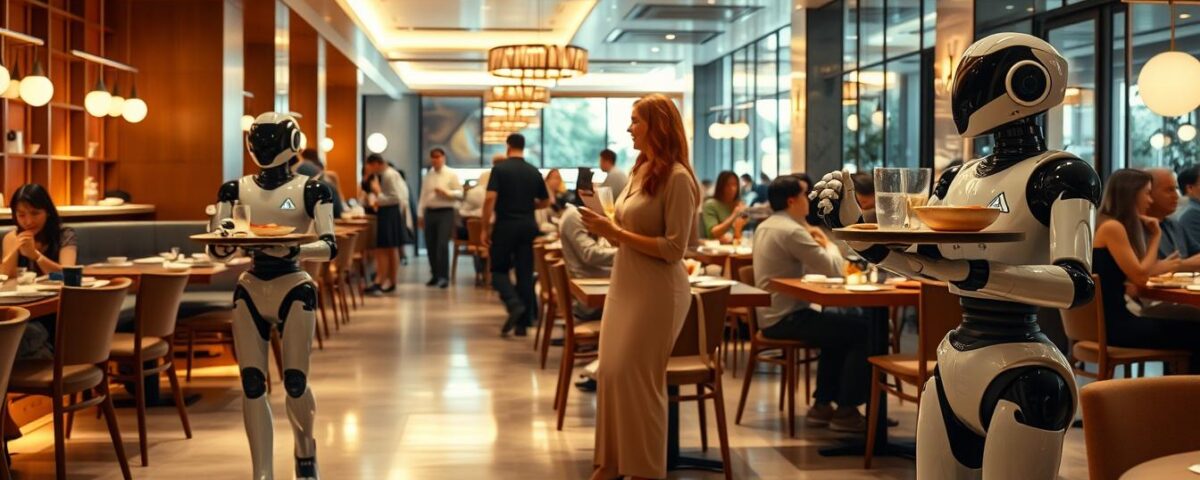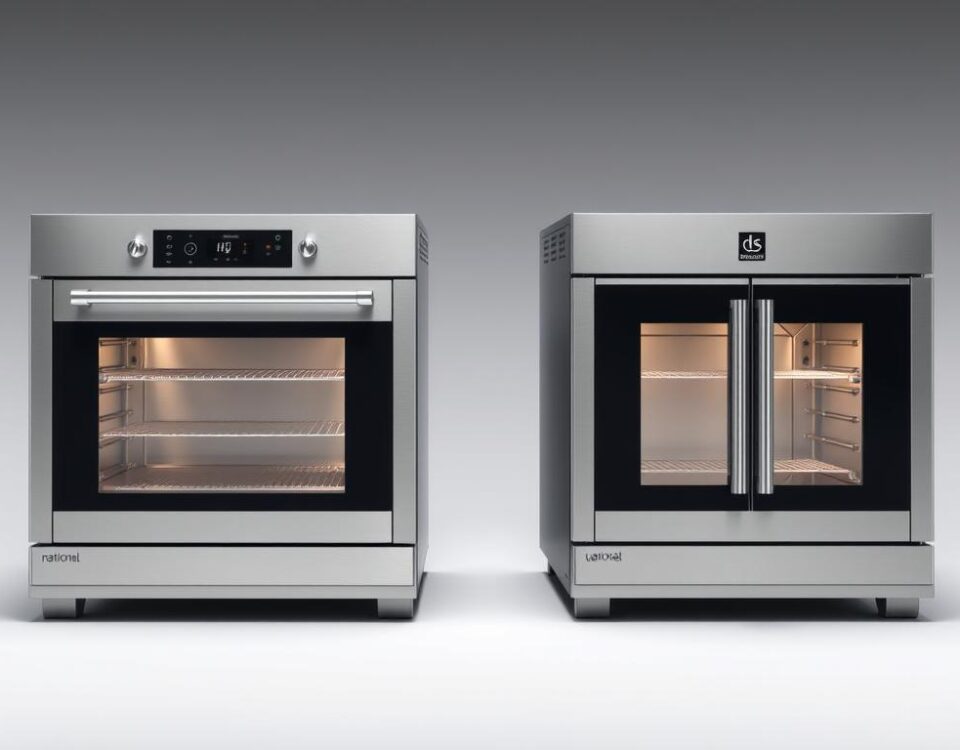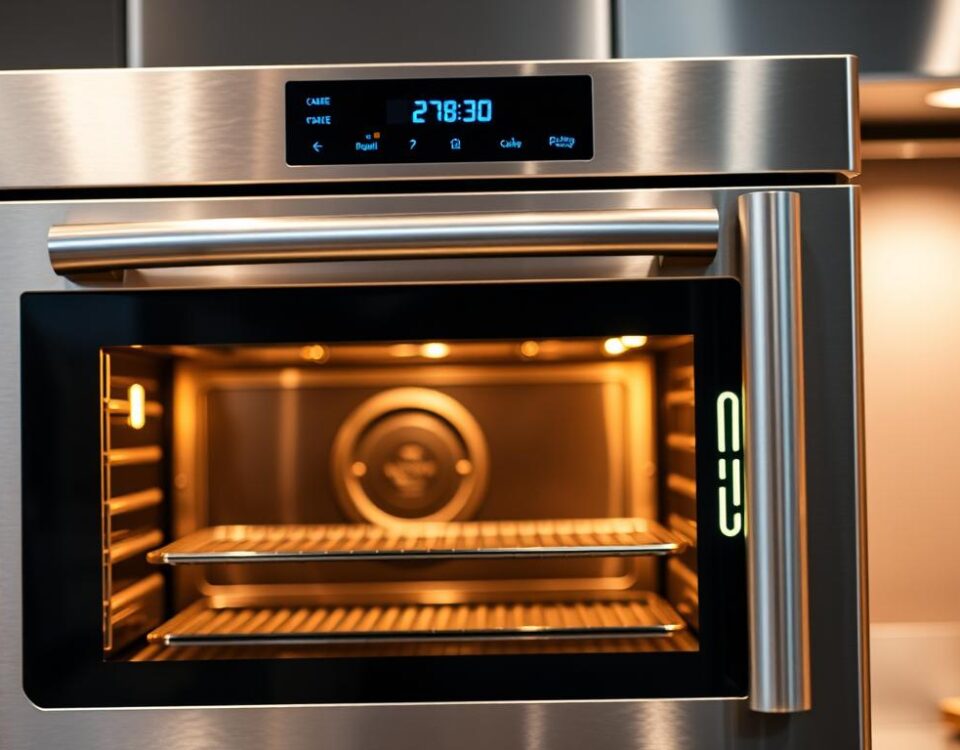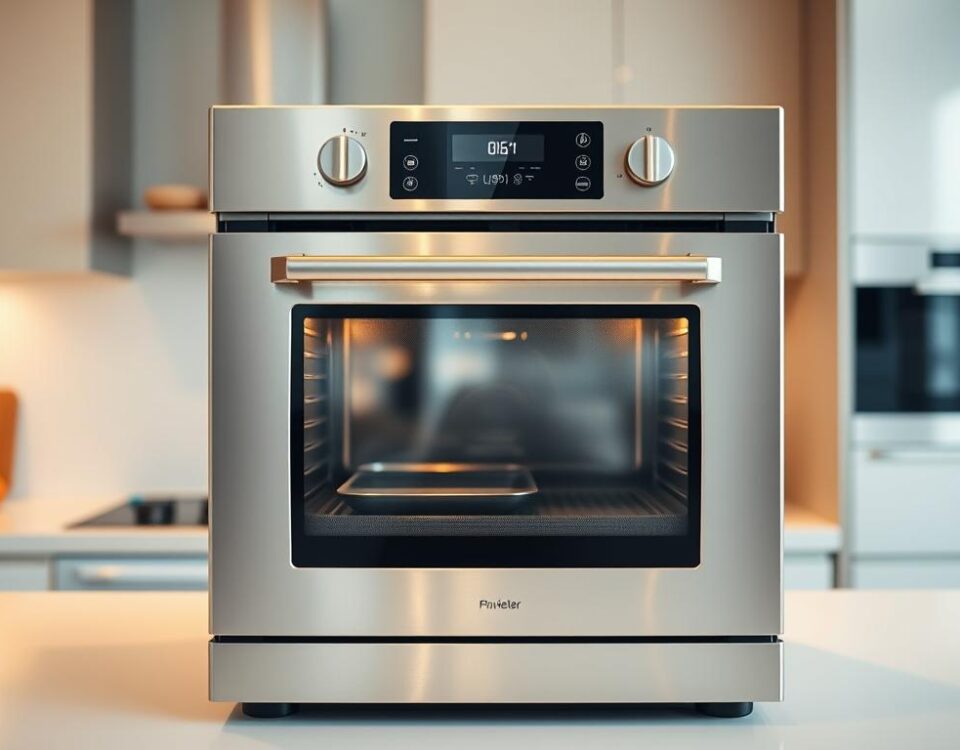
How AI-Driven Menu Engineering Boosts Restaurant Profits
August 7, 2025
Free Food-Cost Calculator: Instantly Price Your Menu for Profit
August 8, 2025As I watched a robot server effortlessly navigate through a bustling restaurant, I realized that the future of dining is being reshaped by technology. Restaurants like Wing Factory in Atlanta and Tastee Spoon are already leveraging robots to complement their human staff, not replace them. This blend of technology and human touch is revolutionizing the industry.
According to a study by Arizton, the robot waiter market is projected to reach $1.97 billion by 2028, highlighting the growing trend of automation in the service industry. As labor shortages continue to challenge restaurants, the debate between robot servers and human staff is becoming increasingly relevant.
The key question is: can a hybrid model that combines the efficiency of robots with the warmth of human service create a superior dining experience? As I explore this topic further, it becomes clear that finding the right balance between technology and human connection is crucial for the future success of the restaurant industry.
Key Takeaways
- The restaurant industry is adopting a hybrid model that combines robot servers and human staff to address labor shortages.
- Restaurants like Wing Factory and Tastee Spoon are successfully integrating robots into their operations.
- The robot waiter market is expected to reach $1.97 billion by 2028.
- A hybrid model can potentially create a superior dining experience by balancing efficiency and human touch.
- The key to success lies in finding the right balance between technology and human connection.
The Rise of Robot Servers in the Restaurant Industry
The use of robot servers in restaurants is on the rise, driven by technological advancements. This trend is transforming the way restaurants operate, making them more efficient and cost-effective.
Post-Pandemic Labor Challenges
The COVID-19 pandemic has had a lasting impact on the restaurant industry, particularly in terms of labor challenges. Many restaurants struggled to maintain staffing levels due to health concerns and changing workforce dynamics. As a result, there has been an increased interest in automation and the use of robots to fill labor gaps.
The pandemic highlighted the need for restaurants to adapt to unforeseen circumstances. With labor shortages becoming more common, restaurants are turning to robot servers to ensure continuity of service. These robots are capable of performing various tasks, from seating customers to serving food and drinks.
Technology Advancements Making Robots More Accessible
Recent technological advancements have made robots more accessible to restaurants of all sizes. Modern restaurant robots are equipped with advanced sensors, cameras, and AI technology, enabling them to navigate complex environments safely.
For instance, Pudu Robotics’ BellaBot features three RGBD depth cameras that can detect obstacles and stop in as little as half a second. Companies like Richtech Robotics are also improving their robots’ interactive software, allowing for more sophisticated interactions with customers.
| Robot Model | Key Features | Benefits |
|---|---|---|
| BellaBot | Three RGBD depth cameras, AI technology | Enhanced safety, efficient navigation |
| ADAM | Interactive software, sophisticated conversations | Improved customer interaction, personalized service |
The decreased cost and complexity of implementing robot servers have made them a viable option for independent restaurants, not just large chains. Leasing options are now available, further reducing the barrier to entry.
As technology continues to evolve, we can expect to see even more innovative applications of robots in the restaurant industry, enhancing the dining experience and improving operational efficiency.
Robot Servers vs Human Staff: Analyzing the Pros and Cons
The restaurant industry is at a crossroads, weighing the benefits of robot servers against the value of human staff. As we explore this dynamic, it’s crucial to consider both the advantages and limitations of each.
Robot Server Advantages
Robot servers bring several benefits to the table, enhancing the dining experience in unique ways.
Cost Efficiency and ROI
One of the primary advantages of robot servers is their potential for cost efficiency and return on investment (ROI). Unlike human staff, robots do not require salaries, benefits, or time off, potentially reducing labor costs over time. However, the initial investment in robotic technology can be substantial.
Consistency and Reliability
Robots excel at providing consistent and reliable service. They can perform repetitive tasks with precision, ensuring that orders are fulfilled accurately and efficiently. This consistency can enhance the overall dining experience, making it more predictable and reliable for customers.
Human Staff Strengths
While robots have their advantages, human staff bring unique qualities to the dining experience that are hard to replicate with automation alone.
Emotional Intelligence and Adaptability
Human servers possess emotional intelligence and the ability to adapt to a wide range of situations, from handling customer complaints to accommodating special requests. Their ability to empathize with customers and provide personalized service can significantly enhance the dining experience.
Complex Task Management
Experienced human servers can juggle multiple responsibilities simultaneously, such as taking orders, answering questions, and processing payments, with a fluidity that robots currently cannot match. They are also adept at handling unexpected situations and exceptions, like managing allergies or special occasions, with nuanced responses that go beyond programmed algorithms.
In conclusion, both robot servers and human staff have their strengths and weaknesses. The ideal approach may lie in a hybrid model that leverages the efficiency and consistency of robots while retaining the emotional intelligence and adaptability of human staff.
Real-World Implementation: Success Stories and Failures
The use of robots in the restaurant industry has yielded both positive and negative results, providing valuable lessons for future implementations. As we explore the real-world applications of robot servers, it becomes clear that success is not solely dependent on the technology itself, but also on how it is integrated into the existing service model.
Success Cases: Wing Factory and Tastee Spoon
Some restaurants have successfully incorporated robot servers into their operations. For instance, Wing Factory and Tastee Spoon have both seen positive outcomes from their robotic implementations. These establishments have managed to strike a balance between automation and human service, enhancing the customer experience. At Wing Factory, robots have been used to streamline food delivery, reducing wait times and increasing efficiency. Similarly, Tastee Spoon has utilized robots to augment their staff, allowing human servers to focus on more complex tasks and improving overall service quality.
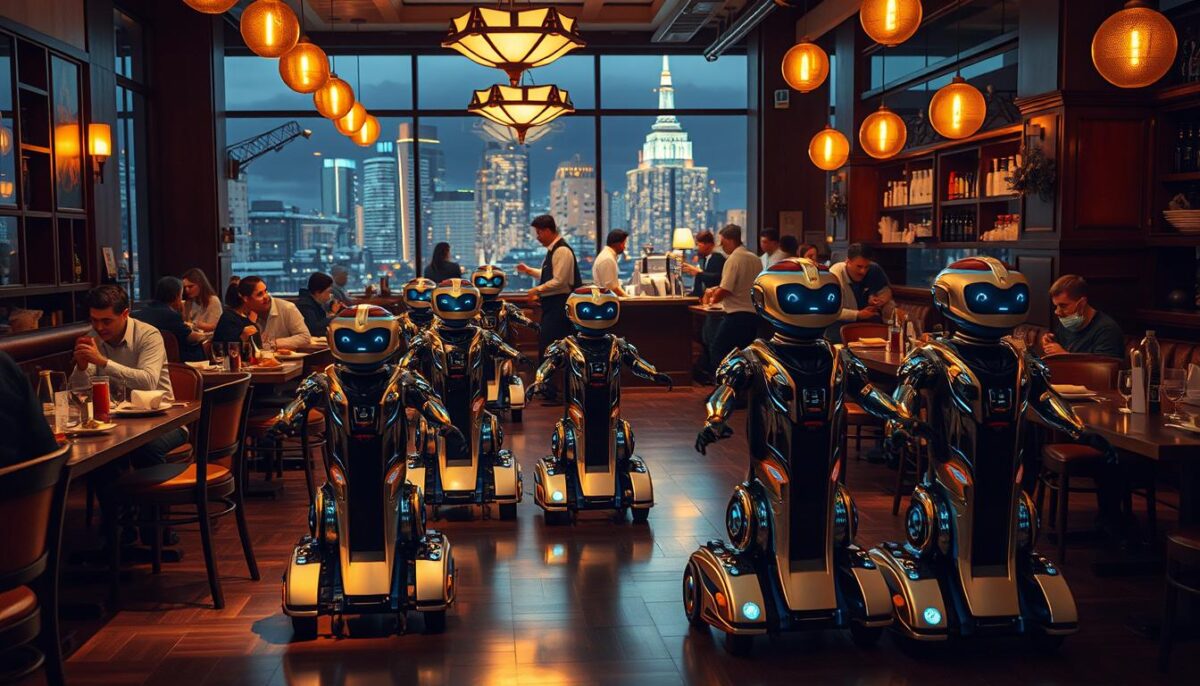
The success of these establishments can be attributed to their thoughtful integration of robots into their service models. By defining clear roles for both robots and human staff, they have created a seamless dining experience for their customers. This hybrid approach has not only improved operational efficiency but also enhanced customer satisfaction.
Cautionary Tales: Chili’s and Haidilao’s Robot Experiments
Not all attempts at integrating robot servers have been successful. Chili’s introduction of a robot server named Rita in 2020, which was later expanded to 61 U.S. restaurants, ultimately ended in failure. The chain found that Rita moved too slowly and interfered with the workflow of human servers. Moreover, 58% of surveyed guests reported that Rita did not improve their overall dining experience. Similarly, Haidilao, a Chinese hot pot chain, experienced reliability issues with their robot servers, with frequent breakdowns limiting their practical utility.
These cautionary tales highlight the importance of careful planning and consideration in the implementation of robot servers. Restaurants that attempt to replace human servers entirely or deploy robots without clearly defined roles are likely to encounter significant challenges and customer dissatisfaction. The key takeaway from these examples is that technology alone cannot solve operational challenges; successful implementation requires thoughtful integration that enhances rather than disrupts the dining experience.
The Economics Behind Robot Integration
As restaurants increasingly adopt robot servers, understanding the economic implications becomes crucial for industry stakeholders. The introduction of robots into the dining service is not just about replacing human labor; it’s about creating a more efficient and cost-effective service model.
Initial Investment vs. Long-Term Savings
The initial investment in robot servers can be substantial, including the cost of purchasing or leasing the robots, integration into existing systems, and staff training. However, these upfront costs can lead to significant long-term savings. For instance, robots can work around the clock without breaks, reducing labor costs associated with human servers. According to industry reports, restaurants that have implemented robot servers have seen a reduction in labor costs by up to 30%.
| Cost Component | Human Servers | Robot Servers |
|---|---|---|
| Labor Costs | High | Low |
| Training Costs | High | Moderate |
| Maintenance Costs | Low | High |
Impact on Tipping and Revenue
The impact of robot servers on tipping and revenue is a critical aspect of their economic integration. Contrary to concerns that robots might reduce tips, evidence suggests that human servers can actually receive higher tips when assisted by robots. Carlos Gazitua, CEO of Sergio’s Restaurants, reported that his staff received more tips after implementing Servi robots because they could focus more on customer interaction. This hybrid model, where robots handle routine tasks like food delivery and bussing, allows human servers to provide more attentive service, potentially increasing both tips and table turnover.
By leveraging robots to enhance their productivity, restaurants can create a more efficient service model that benefits both staff and customers. The optimal economic model involves robots handling 60-80% of food running and bussing tasks while humans manage customer-facing interactions, maximizing efficiency without sacrificing service quality.
Customer Perception and Experience
As restaurants increasingly adopt robot servers, understanding customer perception becomes crucial. The way customers interact with and perceive these robots can significantly impact their dining experience.
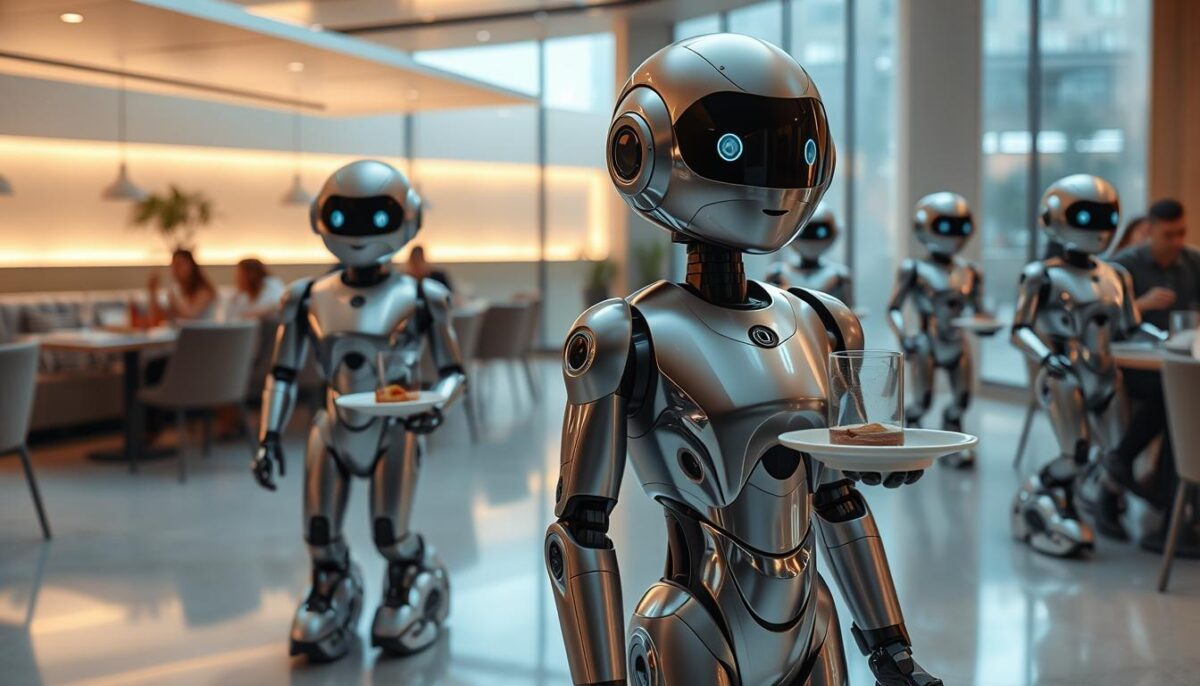
Novelty Factor and Social Media Impact
The introduction of robots in restaurants often creates a novelty that can attract customers, especially tourists and first-time visitors. Many are eager to share their experiences on social media, generating buzz around the restaurant. For instance, a restaurant featuring robot servers may see an increase in social media posts and reviews, as customers are drawn to the unique aspect of being served by a machine.
However, not all customers are equally enthusiastic. According to restaurant manager Lilly Ni, about 20% of her customers, particularly regulars, prefer human service over robots because they value the personal connection and conversation that technology cannot provide. As Saru Jayaraman of One Fair Wage pointed out, “Humans don’t go to a full-service restaurant to be served by technology; they go for the experience of being served by a human.”
| Customer Segment | Preference |
|---|---|
| Tourists and First-Time Visitors | Enjoy novelty of robot service |
| Regular Customers | Prefer human staff for personal connection |
Balancing Technology with Human Touch
To create an ideal dining experience, restaurants must strike a balance between technological efficiency and meaningful human interaction. I’ve observed that the most successful restaurants maintain human staff for greeting, taking orders, and checking on tables, while using robots for behind-the-scenes tasks that don’t diminish the personal connection.
For example, a restaurant might use robots to prepare or deliver food, while human staff handle customer interactions. This approach allows customers to benefit from the efficiency of technology while still enjoying the personal touch of human service. By carefully considering their brand positioning and target audience, restaurants can implement robot servers in a way that enhances their overall service philosophy.
In conclusion, customer perception and experience are critical factors in the successful integration of robot servers in restaurants. By understanding the preferences of different customer segments and balancing technology with human touch, restaurants can create a unique and enjoyable dining experience that leverages the strengths of both.
Conclusion: Why the Hybrid Model Represents the Future of Restaurant Service
As we’ve explored, the synergy between robots and humans is transforming the restaurant landscape. The future of restaurant service lies in striking a balance between technology and human touch. By integrating robots into specific roles, such as food running and bussing tables, restaurants can enhance efficiency while maintaining human staff for personalized interactions.
This hybrid model allows robots to handle repetitive tasks, freeing human servers to focus on delivering exceptional customer experiences. As Carlos Gazitua, CEO of Sergio’s Restaurants, noted, “Robots and humans coming together actually make us more human by interacting more with our guests.” By embracing this balance, the restaurant industry can improve service, address labor challenges, and create a more enjoyable dining experience for customers. With robots augmenting human capabilities, the future of restaurant service is bright.
FAQ
What are the primary benefits of using robot servers in restaurants?
Robot servers can help alleviate labor shortages, reduce labor costs, and increase efficiency in food delivery. They can also provide a unique dining experience, attracting customers who are curious about technology.
Will robot servers replace human workers entirely?
While robot servers are becoming increasingly popular, they are not likely to replace human workers entirely. A hybrid model that combines the strengths of both robots and humans is likely to be the most effective.
How do robot servers impact the customer experience?
Robot servers can enhance the customer experience by providing a novel and engaging way to receive food and interact with the restaurant. However, it’s essential to strike a balance between technology and human touch to ensure a positive experience.
What are some challenges associated with implementing robot servers?
Initial investment costs, technical issues, and potential job displacement are some of the challenges associated with implementing robot servers. Restaurants must carefully weigh these factors when considering robot integration.
Can robot servers be customized to fit a specific restaurant’s needs?
Yes, companies like Bear Robotics are developing robot servers that can be tailored to meet the specific needs of individual restaurants. This can include customizing the robot’s design, functionality, and software.
How do robot servers handle complex orders or special requests?
While robot servers are becoming increasingly sophisticated, they may still require human intervention for complex orders or special requests. Restaurants can implement systems that allow customers to input their orders directly into the robot’s system, reducing errors.
